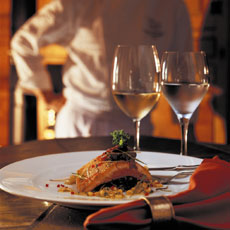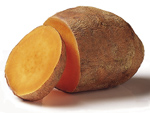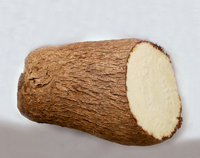 
Cozy up on to fresh wild salmon at Clayoquot Wilderness Resort. Shown here is another of Chef Timothy May’s salmon preparations.
September 2007
|
 |
Recipe: Salmon With Mashed Yams
And An Elegant Pecan Celery Broth
Imagine yourself curling up on a oversized velvet sofa, eating a plate full of local wild sockeye salmon, caught fresh and cooked for you. Sound tempting? Then visit Clayoquot Wilderness Resort for some “glamping,” or glamour camping. Chef Timothy May will prepare his seafood dishes pulled right from the ocean and you can enjoy them by the fire. Go to WildRetreat.com to learn more, and in the interim, make this dish at home. Try to find wild salmon instead of farmed salmon—it tastes so much better, and it’s better for you. Also see Chef May’s seafood chowder recipe.
This recipe takes the unusual approach of pairing salmon with yams—two “orange” foods that are delicious individually, and doubly delicious on the same plate. Which begs the question:
What’s The Difference Between A Sweet Potato And A Yam?
The answer is: You have to clarify whether the person is specifying a sweet potato yam or an Afro-Caribbean yam. Authentic yams are white-fleshed, starchy tubers that come from Africa. Here’s how the colorful sweet potato, indigenous to South America, took on the name of the nyami (Anglicized to yam)—a totally unrelated starchy tuber from Africa.
Orange-fleshed sweet potatoes made their way north from Peru and Ecuador and have been grown by native Americans, and subsequently cultivated in the southern U.S. since Colonial times. There are two different varieties of sweet potato, which will explain why some sweet potatoes aren’t so sweet, or so colorful. The paler-skinned sweet potato is softer with a thin, light yellow skin with pale yellow flesh; it has a dry, crumbly texture similar to a white baking potato. The harder, darker-skinned sweet potato is that which we generally think of when we think of sweet, orange flesh.
The African slaves called the softer sweet potatoes “yams” because they resembled the nyami they knew in Africa. African and Caribbean immigrants wouldn’t bring the real nyami, the white-fleshed African yam, to America until the latter 20th century, when they would appear in international groceries. By that time, most of America had only known “yams” as yellow-fleshed potatoes that weren’t particularly sweet, and sweet potatoes as sweeter-fleshed varieties with deeper-colored flesh.
Some myths said that yams were older sweet potatoes, after the sugar had converted to starch and the more colorful flesh had faded. Those encountering long, rough, brown tubers called yams in international markets, or ordering them in Caribbean and Latin American restaurants and getting something white and starchy, have every right to be thoroughly confused. We are living in a multi-yam society, with American yams and African yams, and many consumers still thinking that an American yam is the same as a sweet potato.
Here’s a comparison:
| |
Sweet Potato & Domestic Yam |
True Yam |
| |
 |
 |
| Scientific Name |
Ipomoea batatas |
Dioscorea Species |
| Plant Family |
Morning Glory (Convolvulaceae) |
Yam (Dioscoreaceae) |
| Origin |
South America (Peru, Ecuador) |
West Africa, Asia |
| Age |
Prehistoric |
50,000 B.C.E. |
| Skin |
Smooth and thin; yellow/tan to darker orange/tan, red and purple |
Rough and scaly; the color is brown or brownish-black |
| Flesh |
The color can range from white to yellow, orange, or orange-red |
Generally white, although some varieties can have purple or red flesh |
| Shape |
Short, blocky, tapered ends |
Long, cylindrical, some with “toes”; often sold in chunks, since they can grow to 7 feet in length |
| Mouthfeel |
Moist* |
Dry |
| Taste |
Sweet* |
Starchy |
| Calories, ½ Cup |
103 |
79 |
| Provenance |
United States |
Caribbean |
| Varieties |
Sweet potatoes: Jersey, Kotobuki (Japanese), Okinawan (Purple), Papa Doc
Yams: Beauregard, Covington, Garnet, Jewel
|
There are about 500 species of the genus Dioscorea of the Dioscoreaceae family |
*Most varieties grown in the U.S.
Recipe Ingredients
- 4 5-ounce salmon fillets†
- 5 medium yams
- 3 celery stalks, small dice
- 4 shallots, peeled and diced
- 6 cloves garlic, minced
- 1 ounce fresh chives, small dice
- Olive oil
- 2 teaspoons toasted chopped pecans
- ¼ cup scallions, sliced thin
- 1 cup fish stock (can substitute vegetable stock)
- 1 teaspoon fresh thyme, chopped plus 4 sprigs for garnish
- Sea salt to taste
- Cracked black peppercorns to taste
†Chef May uses wild sockeye salmon, fished near the resort. You can use whatever is freshest. Wild salmon makes a big difference in flavor, and is preferable to farmed salmon.
Directions
Salmon Fillet
-
Season the salmon fillet with cracked black peppercorns and a pinch of sea salt. Place olive oil in a hot pan over medium heat.
-
Sear the salmon skin side up until golden brown. Turn the salmon over and cook in the oven for approximately 5 minutes at 350°F. Set aside and keep warm.
Pecan Celery Broth
- Sauté shallots and garlic over medium heat until transparent. Add the celery and continue to sweat the celery.
- Add sea salt and black pepper and deglaze the pan with fish stock (vegetable stock is a good substitute). Bring to a simmer and season to taste.
- Add chopped pecans and fresh thyme. Keep warm.
Yam Mash:
- Bake whole yams at 425°F until soft. Peel the skin and mash with a potato masher. Season with sea salt and black pepper. Keep warm.
- When ready to plate, portion the yams in the middle of the warm soup plates. Place a salmon fillet on top of each mound of yams. Spoon the warm celery broth over top of the salmon and garnish with a fresh thyme sprig and scatter chives.
Serves four.
MORE SEAFOOD RECIPES
Recipe and recipe photo courtesy of Clayoquot Wilderness Resort © 2007. All rights reserved. Additional material © Copyright 2005-
Lifestyle Direct, Inc. All rights reserved. Images are the copyright of their respective owners.

|






